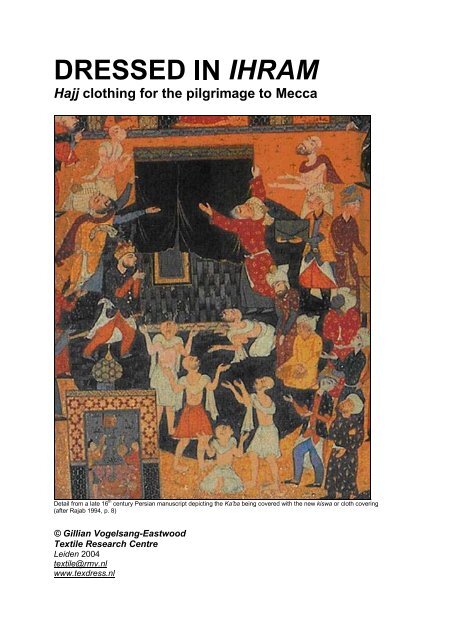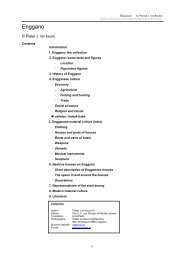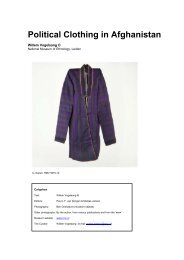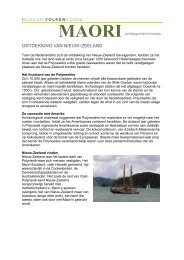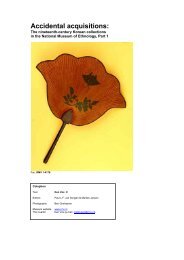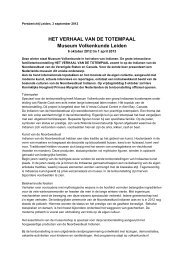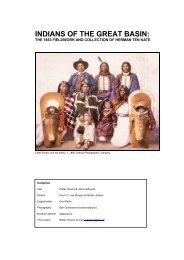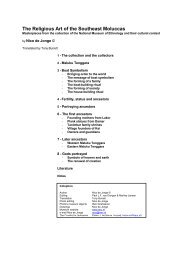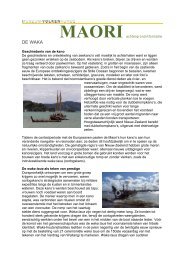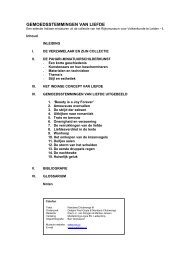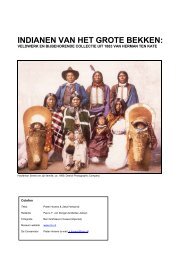DRESSED IN IHRAM: - Museum Volkenkunde
DRESSED IN IHRAM: - Museum Volkenkunde
DRESSED IN IHRAM: - Museum Volkenkunde
- No tags were found...
Create successful ePaper yourself
Turn your PDF publications into a flip-book with our unique Google optimized e-Paper software.
<strong>IHRAM</strong>Hajj clothing for the pilgrimage to MeccaDetail from a late 16 th century Persian manuscript depicting the Ka'ba being covered with the new kiswa or cloth covering(after Rajab 1994, p. 8)© Gillian Vogelsang-EastwoodTextile Research CentreLeiden 2004textile@rmv.nlwww.texdress.nl
Table of contentsIntroduction<strong>DRESSED</strong> <strong>IN</strong> <strong>IHRAM</strong>. HAJJ CLOTH<strong>IN</strong>G FOR THE PILGRIMIGE TO MECCA © GILLIAN VOGELSANG - EASTWOODTextile Research CentreDigital publications of the National <strong>Museum</strong> of Ethnology1. The HajjThe Five Pillars of IslamWhat is the Hajj?The Ka'baIhramSpiritual ihramPhysical ihramWhere and when is ihram worn?The 'Umra or Lesser PilgrimageThe five days of Hajj2. Men's IhramAppearanceWhat is forbidden?How is ihram worn during the Hajj?3. Women's IhramDaily lifeFaceveils4. ConclusionLiteratureLinks to other websitesColophon and acknowledgements1
<strong>DRESSED</strong> <strong>IN</strong> <strong>IHRAM</strong>. HAJJ CLOTH<strong>IN</strong>G FOR THE PILGRIMIGE TO MECCA © GILLIAN VOGELSANG - EASTWOODTextile Research CentreDigital publications of the National <strong>Museum</strong> of EthnologyIntroductionOnce a year up to two million people descend on the Holy City of Mecca, in Saudi Arabia, to performthe Hajj or Pilgrimage. On entering Mecca the pilgrims are dressed in ihram.“Dressed in ihram” is a way of describing the state of purity for the mind, body and soul, which allMuslims should be in when they become participants in the Hajj. But it also describes the actualclothing worn by the pilgrims as they carry out the various rituals of the Hajj, which is one of the “FivePillars of Islam”.All men have to wear a special ihram outfit, with the idea that all men wear the same garments nomatter where they come from or what their status is. On the other hand, women should wearrespectable and subdued versions of their ordinary dress. However, some women wear a specialihram version of their region’s traditional dress.2
<strong>DRESSED</strong> <strong>IN</strong> <strong>IHRAM</strong>. HAJJ CLOTH<strong>IN</strong>G FOR THE PILGRIMIGE TO MECCA © GILLIAN VOGELSANG - EASTWOODTextile Research CentreDigital publications of the National <strong>Museum</strong> of Ethnology1. The HajjThe Five Pillars of IslamAn essential element of the Muslim faith is formed by the “Five Pillars of Islam.” They are regarded asthe foundation stones of Muslim life. The Five Pillars are:Shadada: a declaration of faith, which is regularly repeated.Salat: salat is a prayer ritual, which is performed five times a day at dawn, mid-day, lateafternoon, sunset and within the first hour after nightfall.Figurine of praying muslim (RMV 957-11) and prayer beads (RMV 807-47)Zakah: a principle of Islam is that everything belongs to God, therefore wealth is held in trust.The word zakah means “purification” and “growth.” The system of zakah means that a personputs 1/40 (2.5%) of his personal wealth on one side for charitable purposes.Sawm: every year at the month of Ramadan, all Muslims fast from dawn until sunset. The fastis regarded as a method of self-purification and self-restraint.Hajj: if possible an adult Muslim should make a pilgrimage to Mecca.What is the Hajj?The fifth and last Pillar of Islam is the Hajj. This pillar requires that any adult Muslim who is physicallyand financially able should try to make the Hajj or pilgrimage to the Holy City of Mecca in modernSaudi Arabia once in his or her lifetime:And when We settled for Abraham the placeof the House: “Thou shall not associatewith Me anything. And do thou purifyMy House for those that shall go about itand those that stand, for those that bowand prostrate themselves;and proclaim among them the Pilgrimage,and they shall come unto thee on foot,and upon every lean beast, they shall come fromevery deep ravine,that they may witness things profitable to themand mention God’s Name on days well-knownover such beasts of the flocks as He hasprovided them: “So eat therefore, and feedthe wretched poor.”Let them then finish with their self-neglectand let them fulfil their vows, and go aboutthe Ancient House (Quran 22:26-30).3
<strong>DRESSED</strong> <strong>IN</strong> <strong>IHRAM</strong>. HAJJ CLOTH<strong>IN</strong>G FOR THE PILGRIMIGE TO MECCA © GILLIAN VOGELSANG - EASTWOODTextile Research CentreDigital publications of the National <strong>Museum</strong> of EthnologyFigure 1: Thousands of pilgrims circumambulate the Ka'ba (Amin 1978, p.70).4
<strong>DRESSED</strong> <strong>IN</strong> <strong>IHRAM</strong>. HAJJ CLOTH<strong>IN</strong>G FOR THE PILGRIMIGE TO MECCA © GILLIAN VOGELSANG - EASTWOODTextile Research CentreDigital publications of the National <strong>Museum</strong> of EthnologyThe Hajj is not an obligation for the insane, nor for people without sufficient funds, slaves, or forwomen who are not travelling with a mahram (a close male relative such as her husband, father,brother, or son (the Saudi government now allows women over the age of 46 and travelling with agroup of respectable, Muslim women of the same age or older to travel without individual mahrams).The Hajj is regarded as the peak of a Muslim’s religious duties and aspirations.The pilgrimage takes place from the 8 th to the 13 th day of the last month of the Islamic calendar ofeach year. Because the Islamic calendar is based on the lunar cycle the date of the Hajj changes fromyear to year.The Hajj in general consists of various rituals, some of which recall the acts of Abraham, his wife,Hagar, and their son, Ishmael, when they turned the Ka'ba into the sacred place of worship (Quran,2:119), and in particular the running of Hagar, while she was looking for water for her son. Other actsrecalls the deeds of the Prophet Muhammad. The first group of rituals is called `Umra, while thesecond group is the real Hajj. Both rituals are closely linked and often also known as the Hajj. Beforeeither can take place, however, a pilgrim has to be in a state of ihram and wearing ihram dress.The Ka'baThe first House established for the peoplewas that at Bekka [Mecca], a place holy, and a guidanceto all beings.Therein are clear signs – the station of Abraham,and whosoever enters it is in security.It is the duty of all men towards God to cometo the House a pilgrim, if he is able tomake his way there (Quran 3:96-96).At the centre of several Islamic religious practices is the Ka'ba, a building in Mecca to which Muslimsface when in prayer. The Ka'ba (“Cube”), also simply called the “House”, is a roughly square buildingmade of a hard, dark bluish-grey stone. It is always covered by a cloth called the kiswa, which is madeof black silk and decorated with panels of gold thread embroidery. It stands at the centre of a religiouscomplex called the al-Masjid al-Haram (“The Sacred Shrine”).RMV 1444-2, print of the Ka'ba, and B106-123 and B118-1: fragments of the kiswaAccording to tradition the Ka'ba was built by Adam and following its destruction it was later rebuilt byAbraham and Ishmael. Within the last fifteen hundred years, the Ka'ba has been rebuilt on nineoccasions, including the changes made by the Prophet Muhammad in the early seventh century AD.The present appearance of the whole al-Masjid al-Haram owes much to the twentieth centuryrebuilding by the Saudi authorities in order to accommodate the vast numbers of people who come onHajj.5
<strong>DRESSED</strong> <strong>IN</strong> <strong>IHRAM</strong>. HAJJ CLOTH<strong>IN</strong>G FOR THE PILGRIMIGE TO MECCA © GILLIAN VOGELSANG - EASTWOODTextile Research CentreDigital publications of the National <strong>Museum</strong> of EthnologyFigure 2: Detail from a late 16 th century Persian manuscript depicting the Ka'ba being covered with the new kiswa or clothcovering (after Rajab 1994, p. 8)IhramThe term ihram is used to describe the spiritual state of a person and the garments worn by thepilgrims, especially men.… men wrap themselves with two pieces of unstitched white clothes instead of elegantclothes, which make people distinct from one another. They look like dead people in shroud,detached from the world and entering the realm of submission. A pilgrim takes off the robe ofdisobedience and puts on the garment of piety…(www.al-islam.org/thehajj/7.htm, p.1).Spiritual ihramThe process of being dressed in ihram involves various acts, including the cutting of one’s finger andtoe nails, removal of unwanted body hair, washing and combing the head hair, and the trimming ofbeards and moustaches. These are followed by a purification bath, shower, and wudu (ritual washingnormally carried out prior to saying one’s prayers). The following act is to don ihram clothing. As will beseen later, men wear two sheets of white cloth, while women can wear their ordinary clothing.The pilgrim then says the niyyah, or statement of intention, whereby it is publicly announced that he orshe intends to carry out a pilgrimage. This is followed by a number of specific prayers, and the personis now regarded as being in a state of ihram.The simple nature of the (male) ihram garments is intended to be a reminder of equality; no one isable to show his status and wealth by the type and quality of his clothes.The wearing of ihram is also meant to be a reminder to the pilgrim of his or her mortality, as thegarments were often needed in the past as shrouds for pilgrims who died en route. The situation wasdescribed by al-Ghazali (d. AD 1111):As for buying the ihram garment, at that moment he should reflect on the shroud and how hewill (one day) be wrapped in it. He will wear the ihram garment when he reaches the Lord’sHouse, but it may be that his journey there will never occur. What is sure is that he will faceGod wrapped in his shroud. And just as he may not look upon the Lord’s House except in6
<strong>DRESSED</strong> <strong>IN</strong> <strong>IHRAM</strong>. HAJJ CLOTH<strong>IN</strong>G FOR THE PILGRIMIGE TO MECCA © GILLIAN VOGELSANG - EASTWOODTextile Research CentreDigital publications of the National <strong>Museum</strong> of Ethnologyclothes different from what he usually wears, so after death he cannot see God but in a dressdifferent from his worldly dress (quoted by Peters 1994, p. 115)It is also regarded as a reminder of how people will be on the Day of Resurrection, namely naked andbarefooted.Physical ihramIhram is also the term used for the distinctive garments worn by male pilgrims during both the `Umraand the Hajj. Women are not subject to the same restrictions and are allowed to wear subduedversions of their daily wear. It would not appear, however, that this was always so: there is ananonymous description of the Egyptian Hajj caravan from about AD 1575, for instance, which seemsto suggest that women also wore the two part ihram dress:When the next morning by the sun rising, the Caravan arrives at Bedrhonem [Badr Hunayn inthe Hijaz], in which place every man washes himself from top to toe, as well men as women,and leaving off their apparel, having each one a cloth about their privities … and another whiteone upon their shoulders, all which can go to Mecca in this habit do so, and are thought tomerit more than the other, but they which cannot do so vow to sacrifice a ram at the mountainof pardons. And after they be washed, it is not lawful for any man or woman to kill either flea orlouse with their hands, neither to take them with their nails, until they have accomplished theirvowed orations at the mountain of pardons aforesaid (Anon 1927, vol. 3, p. 185).Nowadays it is normal for men to wear ihram dress while women wear their own, respectable form ofclothing. This point will be returned to later.Where and when is ihram worn?There is an imaginary boundary around Mecca called miqat (pl. mawaqit). A pilgrim cannot cross thisboundary without first entering a state of ihram and wearing ihram. A pilgrim in the state of ihram andwearing ihram is called a muhrim.The place where most pilgrims change their status reflects the ancient pilgrim routes by land fromSyria and Yemen, and by sea from Egypt and India and further east. The main mawaqit around Meccaare Zhal Hulaifa (north), Dhat Irq (north-east), Al-Djuhfa (north-west), Yalamlam (south-east), andQarn al-Manazil (east).Figure 3: Map showing the position of the main mawaqit around Mecca7
<strong>DRESSED</strong> <strong>IN</strong> <strong>IHRAM</strong>. HAJJ CLOTH<strong>IN</strong>G FOR THE PILGRIMIGE TO MECCA © GILLIAN VOGELSANG - EASTWOODTextile Research CentreDigital publications of the National <strong>Museum</strong> of EthnologyFigure 4: Pilgrims arriving for the Hajj (Amin 1978, p. 40).Nowadays with the advent of air travel, pilgrims are advised either to don ihram prior to stepping onboard the airoplane or at least one hour before arriving at the airspace over Mecca.The `Umra or Lesser PilgrimageThe word `Umra means a visit, literally a visit to the Ka'ba. Although the `Umra can be carried out atany time of the year, many Muslims combine the `Umra with the real Hajj.After entering the state of ihram a pilgrim goes to Mecca and enters the Masjid al-Haram. Here theTawaf is performed, which involves circling the Ka'ba seven times in an anti-clockwise direction.During the whole time a pilgrim constantly says a series of prayers and carries out a number of acts.The pilgrim then goes to and drinks from the well of Zamzam, which is now enclosed in a marblechamber close to the Ka'ba. The spring is said to have appeared at the feet of Ishmael during Hagar’ssearch for water between the hills of Safa and MarwahRMV 1973-70, 1973-142 and B106-88, Zamzam water containers.8
<strong>DRESSED</strong> <strong>IN</strong> <strong>IHRAM</strong>. HAJJ CLOTH<strong>IN</strong>G FOR THE PILGRIMIGE TO MECCA © GILLIAN VOGELSANG - EASTWOODTextile Research CentreDigital publications of the National <strong>Museum</strong> of EthnologyThe pilgrims then perform the sa‛y, which means walking seven times between the hills of Safa andMarwah. These hills are situated to the south and north of the Ka'ba respectively. Nowadays, there areonly vague signs of these hills and the whole route between them is enclosed in a long gallery.After a pilgrim has carried out the sa‛y, men are expected to shave their heads or have their hairclipped very short, while women have two to three centimetres trimmed from their hair or a lock of haircut off. This act releases the pilgrims from the state of ihram and normal clothing may be resumed.The Five Days of HajjThe Hajj can only take place on the five days between the 8 th and the 13 th day of Dhul-Hijjah, the lastmonth in the Islamic lunar calendar. There are three types of Hajj, which are in hierarchical order:Ifrad Hajj (Single)At the miqat a pilgrim of Ifrad Hajj declares his/her intention for the main Hajj only (thus he/she doesnot perform the `Umra). The pilgrim is released from ihram on the day of sacrifice at Mina, at the endof the Hajj.Tamattu Hajj (Interrupted)The second form of Hajj is the Tamattu Hajj. The Tamattu, which is the most commonly carried outform of Hajj, involves performing the `Umra during the Hajj season and prior to the main Hajj. Normallya pilgrim carries out the `Umra, takes off his or her ihram dress and wears normal clothing, and thenon the evening of Tarwaiah (the first day of the Hajj) re-enters the state of ihram ready for the mainHajj.Qiran Hajj (Combined)In this type of Hajj, a pilgrim declares his or her intention to perform both the `Umra and the Hajjtogether, so that the rites of the `Umra are included in the act of the main pilgrimage. The restrictionsof ihram apply to the whole period and ihram is only taken off on the day of sacrifice.Figure 5: Map showing the location of the main sites associated with the HajjThe following is a summary of the rites performed during the five days of the main Hajj.The evening before the HajjOn the evening before the 8 th day of Dhul-Hijjah, a pilgrim takes a bath and enters the state of ihram,and starts wearing ihram dress (if this has not already been adopted). The pilgrim then says a seriesof prayers, including the Talbiyah, which a Muslim recites once he or she is in ihram and has made hisor her intention to become a pilgrim known.Day One: on the 8 th day of Dhul-Hijjah, the pilgrim travels to Mina, some three miles from Mecca. Thepilgrim stays there overnight and recites various prayers.Day Two: “The Day of Arafat” (Yaumul-`Arafah): at sunrise on the morning of the 9 th day of Dhul-Hijjahthe pilgrim travels to the Plain of Arafat, nine miles from Mecca. This is the place where according totradition Muhammad delivered his last sermon. Staying at Arafat is the single most important act of the9
<strong>DRESSED</strong> <strong>IN</strong> <strong>IHRAM</strong>. HAJJ CLOTH<strong>IN</strong>G FOR THE PILGRIMIGE TO MECCA © GILLIAN VOGELSANG - EASTWOODTextile Research CentreDigital publications of the National <strong>Museum</strong> of EthnologyHajj; prayers are constantly said, and people remain standing. Immediately after sunset, the pilgrimsrun to the nearby place of Muzdalifah, halfway between Arafat and Mina, and stay there overnight.While staying at Muzdalifah a pilgrim collects seventy pebbles to be used in Mina.Day Three: “The Day of Sacrifice” (Yaumun Nahr): just before sunrise on the morning of the 10 th ofDhul-Hijjah the pilgrim returns to Mina and later in the day to Mecca. Four important acts are carriedout on this day:Pelting of the big shaitan (Ramee or Jamratul `Aqabah): after reaching Mina, thepilgrim has to carry out the ramee or the symbolic stoning of the devil (shaitan) bythrowing pebbles against the largest of three pillars. This usually takes place betweenmidday and dusk prayer. Seven pebbles are thrown while the pilgrim recites:bismillahi allahu akber (“in the name of Allah, Allah is great”)The next act is the sacrifice of an animal in memory of Abraham’s sacrifice of ananimal instead of his son. A sheep, goat, camel or cow can be sacrificed. During theslaughter of the animal certain prayers are said. Normally a professional butcher isemployed.Halaq: after the sacrifice of the animal, the head of a male pilgrim is completelyshaven. Women usually have their hair trimmed by about 2.5 cm. After the hair hasbeen shaven it is permissible for the pilgrim to remove his or her ihram clothing, take abath, trim the moustache, clip finger nails and use hair oil and perfume. All restrictionsare relaxed.Tawafuz-Ziyarah: the seven-fold circumambulation of the Ka'ba at Mecca whilereciting prayers. If the sa‛y has not yet taken place, then it must occur now.The pilgrims then return to Mina to spend the night.Day Four: On the 11 th of Dhul-Hijjah the pilgrims continue to stone the three Jimaar. Those who havefinished stoning the pillars spend the rest of the day in prayer and contemplation.Day Five: On the 12 th of Dhul-Hijjah the pilgrim stones the three Jimaar again before either spendingthe night at Mina again or returning to Mecca.At this point all the main acts of Hajj have been performed. The only deed left is for the pilgrim toperform the Tawaf al-Wuda or “Farewell Circumambulation”, just before he or she leaves Mecca forhis next destination. From now on a man is allowed to call himself a Hajji, while a woman is a Hajjah.It is not uncommon for pilgrims to travel afterwards to Medina to visit the “The Prophet’s Mosque”), inorder to pray at the tomb of the Prophet.RMV 1444-1 and 543-10: prints of the mosque of Medina.10
<strong>DRESSED</strong> <strong>IN</strong> <strong>IHRAM</strong>. HAJJ CLOTH<strong>IN</strong>G FOR THE PILGRIMIGE TO MECCA © GILLIAN VOGELSANG - EASTWOODTextile Research CentreDigital publications of the National <strong>Museum</strong> of EthnologyFigure 6: Detail from a medieval manuscript showing the pilgrims around the Ka'ba (after Brend 1991, fig. 2).11
2. Men's Ihram<strong>DRESSED</strong> <strong>IN</strong> <strong>IHRAM</strong>. HAJJ CLOTH<strong>IN</strong>G FOR THE PILGRIMIGE TO MECCA © GILLIAN VOGELSANG - EASTWOODTextile Research CentreDigital publications of the National <strong>Museum</strong> of EthnologyThe nature of men’s ihram garments is laid down in several of the hadiths or traditions, based uponsayings of the Prophet Muhammad.Ibn Umar said (on the authority of the Prophet), the months of the Hajj are Shawwal and Dhual-Qa`da and the first ten days of Dhu al-Hijja. And Ibn Abbas said, it is the custom (of theProphet) that a man shall not enter the state of ritual purity (ihram) except in the months ofpilgrimage (Bukhari, The Sound, 25:34).Ibn Abbas said that the Prophet – may God bestow peace and blessings upon him –appointed for the people of Medina [that is, people coming from Medina] Dhu al-Hulayfa [ZhalHalaifah] as the place where they should enter the state of ihram; for the people of Syria,Juhfa [Al-Djuhfa]; for the people of Najd, Qarn al-Manazil; and for the people of the Yemen,Yalamlam. These are for them and for those who come upon them from other places, forthose who have taken a decision to perform the Hajj and Umra. And for whoever is on thenearer side of these points, the appointed place (for ihram) is where he starts, so that for thepeople of Mecca it is Mecca (Bukhari, The Sound, 25.7).Ibn Umar reported the Prophet – may God bestow peace and blessing upon him – that a manonce asked him, what should a man wear in the state of ihram? He answered, “He shall notwear shirt (qamis), nor turban (`imama), nor trousers (sirwa), nor headgear, nor any dyedcloth; and if he cannot find footwear, then let him wear leather stockings (khuff), but cut off sothat they may be lower than the ankles.”(Bukhari, The Sound, 3:53).Ibn Abbas said, someone in a state of ihram may smell sweet-smelling plants, and look in alooking-glass, and use comestibles as medicines, like olive oil and butter; Ata said, he canwear a ring and carry a purse. When Ibn Umar made the circumambulation while in the stateof ihram he girdled his middle with a cloth. Aisha’s opinion was that there was no harm inwearing underpants (Bukhari, The Sound 25.18).If a man was too poor to have special ihram clothing or was unable to purchase or acquire suitablelengths of cloth, then it was acceptable for him to wear (baggy) trousers (sirwal), but not a shirt(qamis).Ibn Abbas reports that Allah’s Messenger delivered a sermon at Arafat saying, “A Muslim(pilgrim) who finds no suitable garb may wear trousers, and if he finds no suitable slippers, hemay wear shoes.Figure 7: Male pilgrim wearing ihram (Amin 1978, p. 90) and Figure 8: Pilgrim leaving Schiphol airport for the 2004 Hajj(photograph by courtesy of Jörgen Caris and the Trouw newspaper)12
<strong>DRESSED</strong> <strong>IN</strong> <strong>IHRAM</strong>. HAJJ CLOTH<strong>IN</strong>G FOR THE PILGRIMIGE TO MECCA © GILLIAN VOGELSANG - EASTWOODTextile Research CentreDigital publications of the National <strong>Museum</strong> of EthnologyIt was also reported by Nasa’i that such a man:“… must take off his trousers and put on a proper garb when and if he finds one. But if aperson finds no proper upper Hajj garment, he should not wear his shirt, for unlike trousersone can do without it”AppearanceThe traditional ihram dress worn by men consists of two pieces of white, unsewn cloth, one of which isusually about 125 x 300 cm in size (the izar) and covers the lower half of the body. The other is about125 x 180 cm in size (the rida) and covers the upper half. They are usually made out of a cottonmaterial such as towelling, which better absorbs perspiration.Nowadays the garments are normally white, but in the past some colour was included as noted by theEnglish Arabist, Sir Richard Burton (1821-1890), writing about his experiences of the Hajj in AD 1853:… we donned the attire, which is nothing but two new cotton cloths, each six feet long bythree and a half broad, white, with narrow red stripes and fringes: in fact, the costume calledAl-Eddeh, in the baths at Cairo (These sheets are not positively necessary; any clean cottoncloth not sewn in any part will do equally well. Servants and attendants expect the master topresent them with an ihram). One of these sheets, technically termed the Rida, is thrown overthe back, and, exposing the arm and shoulder, is knotted at the right side in the style Wishah.The Izar is wrapped around the loins from waist to knee, and knotted or tucked in at themiddle, supports itself. Our heads were bare, and nothing was allowed upon the instep (Burton1893, II, p. 139).Modern appearance is described as follows:Put one sheet of Ihraam around the lower part of your body (waist below) and bring the twoends together in the front. Holding the ends with the right hand, fold the sheet to the left. Putyour left hand on the left side of your stomach and over the Ihraam. Fold the sheet to the rightside over the hand. Now put the hand over the fold again. Fold one more time to the leftside. Holding all the folds together put a belt around your stomach, leaving about four inches[10 cm] of Ihraam above the belt. Finally fold down the portion of Ihraam over the belt.Take the other sheet of Ihraam and wrap it around the upper body, covering both arms andleaving the head uncovered (Anon, www.islam.tc/alhilaa/site/hajj.html, p. 7).Men are also allowed to wear a bag or belt (himyan) of some kind in order to keep valuable items safe.As seen earlier, according to various hadiths it is necessary to have the ankles and upper part of thefeet uncovered, and that slippers were the preferred form of footwear. Nowadays, most pilgrims wearflip-flop style slippers in white plastic (shib-shib; hawai chappal)In the case of extreme weather conditions, a blanket or towel can be used to cover part of the body.Figure 9: Male pilgrims wearing ihram in the wishah style (Amin 1978, p. 101).13
<strong>DRESSED</strong> <strong>IN</strong> <strong>IHRAM</strong>. HAJJ CLOTH<strong>IN</strong>G FOR THE PILGRIMIGE TO MECCA © GILLIAN VOGELSANG - EASTWOODTextile Research CentreDigital publications of the National <strong>Museum</strong> of EthnologyWhat is forbidden?While in a state of ihram men are not allowed: to wear sewn garments, underwear, gloves or socks to cover their faces or head to use perfume on the body or the ihram cloths. Scented soap should also be avoided to shave or trim hairs from any part of the body, to comb or groom the hair (in case a hair isremoved) to cut finger or toe nails to kill lice, indicating it to others and removing lice from the body or hairHow is ihram worn during the HajjThere are two basic ways for men to wear ihram garments. Wishah or the ‘normal’ form of ihram isworn during most of the`Umra and the Hajj. The garments consist of one piece of cloth (izar) that israpped around the midriff to cover the body from navel to mid-calves or lower; the other (rida) isdraped around the pilgrim’s shoulders to cover the upper body. Burton’s use of the term Wishah forthis style, as quoted above, appears to be wrong.Another way of wearing ihram is called idtiba and is worn during the Tawaf ul Qudom, when a pilgrimfirst enters the al-Masjid al-Haram in Mecca and carries out the seven-fold circumambulation of theKa'ba. In this form of dress the pilgrim drapes one end of the rida over his left shoulder back to front.The other end goes across his back, under his right arm, across his front, and is finally draped over hisleft shoulder, leaving his right shoulder uncovered.Figure 10: Many of the pilgrims in this photograph are wearing ihram in the idtiba style with the right shoulder bare (Amin 1978,p.73).14
3. Women’s ihram<strong>DRESSED</strong> <strong>IN</strong> <strong>IHRAM</strong>. HAJJ CLOTH<strong>IN</strong>G FOR THE PILGRIMIGE TO MECCA © GILLIAN VOGELSANG - EASTWOODTextile Research CentreDigital publications of the National <strong>Museum</strong> of EthnologyAccording to the hadiths it is not necessary for a woman to wear special clothing while in a state ofihram. Women are expected to wear clothing that conceals their shape and covers the bodycompletely, leaving only their faces and hands exposed. According to some authors, however, glovescan be worn. Women are also allowed to wear jewellery (it was regarded as unsafe to leave jewelleryunattended).Figure 11. A late sixteenth century Persian manuscript depicting female pilgrims standing near the Ka'ba, Mecca (after Rogers1986, no. 116).According to the hadith recorded by Abu Dawud:Ibn Umar reported that he heard the Prophet – may God bestow peace and blessings uponhim – forbidding women in the state of ihram the wearing of gloves, a veil [face veil], and dyedgarments, and (adding) that besides these they might wear whatever they liked of garmentscoloured with safflower, or made of silk, or ornaments or trousers or shirt.Daily lifeSome women choose to wear ordinary, daily life clothing. This type of clothing is normally of asubdued colouring (figs. 12 and 13). Nowadays, more and more women are wearing black Saudi styleclothing consisting of an outer garment called an abayeh and a long headscarf (shelagh; see fig. 21).15
<strong>DRESSED</strong> <strong>IN</strong> <strong>IHRAM</strong>. HAJJ CLOTH<strong>IN</strong>G FOR THE PILGRIMIGE TO MECCA © GILLIAN VOGELSANG - EASTWOODTextile Research CentreDigital publications of the National <strong>Museum</strong> of EthnologyFigure 12: A group of women (from left to right) wearing special ihram dress; white clothingover a pale coloured dress; or normal dress (after Amin 1978, p. 35).Figure 13: A family portrait of pilgrims at Schiphol Airport prior to leaving for the 2004 Hajj(photograph by courtesy of Jörgen Caris and the Trouw newspaper)16
<strong>DRESSED</strong> <strong>IN</strong> <strong>IHRAM</strong>. HAJJ CLOTH<strong>IN</strong>G FOR THE PILGRIMIGE TO MECCA © GILLIAN VOGELSANG - EASTWOODTextile Research CentreDigital publications of the National <strong>Museum</strong> of EthnologyFigure 14: Pilgrims leaving Schiphol airport for the 2004 Hajj.(photograph by courtesy of Jörgen Caris and the Trouw newspaper)The second form that is often worn is basically a white version of their traditional dress from home. Soa woman from Morocco would wear a (white) kaftan; a woman from Egypt would wear a galabiyeh,while an Iranian woman would wear a long dress (libas) with a white cloak (chador), and so forth (fig.15).Figure 15: Egyptian Hajj outfit for a woman. (photography by B. Grishaaver)17
<strong>DRESSED</strong> <strong>IN</strong> <strong>IHRAM</strong>. HAJJ CLOTH<strong>IN</strong>G FOR THE PILGRIMIGE TO MECCA © GILLIAN VOGELSANG - EASTWOODTextile Research CentreDigital publications of the National <strong>Museum</strong> of EthnologyA third form of Hajj clothing for a woman consists of either normal clothing or a white Hajj outfit that isworn underneath the two sheets normally associated with male ihram dress. This is not commonlyworn, but it is permitted as long as her hair and head are covered. Sometimes these sheets are leftwhite, on other occasions they are dyed a pale colour.Figure 16: Pilgrims wearing ihram arriving for the Hajj (Amin 1978, p. 44).FaceveilsOne of the more controversial aspects of women’s ihram is whether a woman should wear a faceveilor not. According to a hadith a woman should not have her hands covered nor have any cloth touchingher face.Ibn `Umar reported: “Allah’s Messenger (pbuh 1 ), forbade women pilgrims from wearing gloves,veils ….”Bukhari reported that `A’ishah said: “A woman must neither wear a veil to cover her face, norwear clothes that are dyed with saffron or other fragrant dyeing material”However, some scholars say it is acceptable for a woman to cover her face with something other thana veil, so she may use an umbrella or a similar item as a screen between men and herself. Thisreasoning is based on the following hadith:`A’ishah said: “Men on camels used to pass by us while we were with the Prophet (pbuh), andin the state of Ihram. We would cover our faces with our gowns when they passed by us, andthen uncover them again.” This is reported by Abu Dawud and Ibn Majah.In the past various forms of creating a screen or a curtain rather than an actual faceveil have beenused. In the nineteenth century, for example, Sir Richard Burton described the veils worn by femalepilgrims from Turkey:The wife and daughters of a Turkish pilgrim of our party assumed the Ihram at the same timeas ourselves. They appeared dressed in white garments; and they had exchanged the Lisam,1“Peace be unto Him”18
<strong>DRESSED</strong> <strong>IN</strong> <strong>IHRAM</strong>. HAJJ CLOTH<strong>IN</strong>G FOR THE PILGRIMIGE TO MECCA © GILLIAN VOGELSANG - EASTWOODTextile Research CentreDigital publications of the National <strong>Museum</strong> of Ethnologythat coquettish fold of muslin which veils without concealing the lower part of the face, for ahideous mask, made of split, dried and plaited palm-leaves, with two “bulls’ eyes” for light. Thereason why this “ugly” …….. must be worn is that a woman’s veil during the pilgrimageceremonies is not allowed to touch her face (Burton 1893, II, p. 141).Based on actual examples and photographs it would appear that Indonesian pilgrims wore an evenmore elaborate faceveil made of a long length of material mounted on a bamboo frame. The effectwas of a curtain hanging in front of the wearer’s face.Nowadays, there are two basic views: a faceveil is not necessary, as all pilgrims should be in a state of mental and physical purity. faceveils are not necessary unless a woman is likely to come into contact with men who areoutside the immediate family, in which case her face should be covered.As a result there are some women who decide to wear faceveils and others who do not. In most casesthe veil chosen is a plain coloured niqab.Figure 17: Male and female pilgrims (Burton 1892, II, op. p. 139).19
<strong>DRESSED</strong> <strong>IN</strong> <strong>IHRAM</strong>. HAJJ CLOTH<strong>IN</strong>G FOR THE PILGRIMIGE TO MECCA © GILLIAN VOGELSANG - EASTWOODTextile Research CentreDigital publications of the National <strong>Museum</strong> of EthnologyFigure 18: A late nineteenth century photograph of an Indonesian pilgrim with her faceveil draped over the back of her head(Snouck Hurgronje, 1889, pl. XIXd).Figure 19: A late nineteenth century pilgrim's faceveil and headcover from Indonesia (RMV 370-2992 and 370-2991).20
<strong>DRESSED</strong> <strong>IN</strong> <strong>IHRAM</strong>. HAJJ CLOTH<strong>IN</strong>G FOR THE PILGRIMIGE TO MECCA © GILLIAN VOGELSANG - EASTWOODTextile Research CentreDigital publications of the National <strong>Museum</strong> of EthnologyFigure 20: An Indonesian faceveil and headcovering (RMV 370-2992 and 370-2991)21
4. Conclusion<strong>DRESSED</strong> <strong>IN</strong> <strong>IHRAM</strong>. HAJJ CLOTH<strong>IN</strong>G FOR THE PILGRIMIGE TO MECCA © GILLIAN VOGELSANG - EASTWOODTextile Research CentreDigital publications of the National <strong>Museum</strong> of EthnologyGoing on Hajj and being dressed in ihram is a connecting link between the modern Muslims and themillions of men and women who have carried out the Hajj since the dawn of Islam. In addition, ihramcan be seen as an early form of globalization in dress, which was deliberately encouraged with theideal of making all (male) pilgrims equal, no matter where they came from or what their status was intheir home countries.Yet ihram is also one of those rare occasions in dress history, whereby the rules surrounding the useof a particular set of clothing are much stricter for men than for women. As a result, women’s ihramdress has developed a wider range of forms than for their male counterparts and these forms can beseen to represent individual, ethnic, as well as nationalistic ideas.Figure 21: Female pilgrims wearing black faceveils and abayehs, with white dresses (Amin 1978, p. 51).22
<strong>DRESSED</strong> <strong>IN</strong> <strong>IHRAM</strong>. HAJJ CLOTH<strong>IN</strong>G FOR THE PILGRIMIGE TO MECCA © GILLIAN VOGELSANG - EASTWOODTextile Research CentreDigital publications of the National <strong>Museum</strong> of EthnologyColophon and acknowledgementsI should like to thank the following people in the National <strong>Museum</strong> of Ethnology, Leiden, for their help in thepreparation of this digital account of ihram dress: Marlies Jansen and Willem Vogelsang. I should also like tothank Constance Dia, Jan Fehrman, and Julia AlZadjali for reading the manuscript and making valuablecomments. I should like to thank and acknowledge the generosity of the Trouw newspaper for allowing me to usethree of their photographs in this article, in particular their staff, Wilma Kieskamp and Jörgen Caris.25


